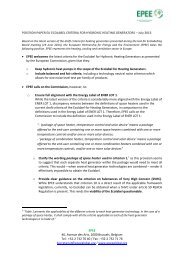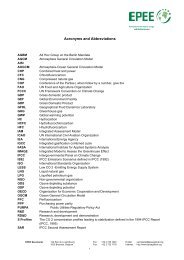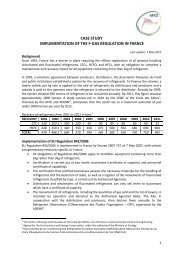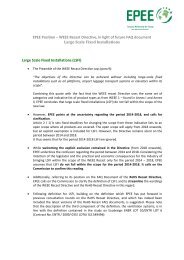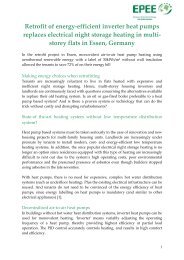EPEE Position Paper â FAQ Document RoHS Recast Directive ...
EPEE Position Paper â FAQ Document RoHS Recast Directive ...
EPEE Position Paper â FAQ Document RoHS Recast Directive ...
You also want an ePaper? Increase the reach of your titles
YUMPU automatically turns print PDFs into web optimized ePapers that Google loves.
Consequently, it is vital that the definitions given by the <strong>RoHS</strong> <strong>Recast</strong> <strong>Directive</strong> (Art. 3(5)<br />
<strong>RoHS</strong> <strong>Directive</strong>: cables means all cables with a rated voltage of less than 250 volts that serve<br />
as a connection or an extension to connect EEE to the electrical outlet or to connect two or<br />
more EEE to each other) are explained sufficiently clearly in the <strong>FAQ</strong> <strong>Document</strong>.<br />
<br />
<br />
The need for clarification is all the more relevant because cables were not part of the scope<br />
of <strong>RoHS</strong> I. Following Art. Article 2(2) of <strong>RoHS</strong> <strong>Recast</strong>, non-compliant EEE that were outside<br />
the scope of <strong>RoHS</strong> I but inside the scope of <strong>RoHS</strong> <strong>Recast</strong> must be granted full market access<br />
until 22 July 2019.<br />
<strong>EPEE</strong> suggests to clarify the definitions as follows:<br />
- Cables, in so far as they qualify under the definition given in this <strong>Directive</strong>, will fall within<br />
its scope from 22 July 2019 onwards.<br />
- Wiring that is contained within or integral to EEE does not meet the definition of "cable"<br />
given in Article 3(5). Instead, such wiring is part of the EEE and must therefore meet the<br />
material restrictions and timescale that apply to the EEE itself.<br />
- For EEE which is out of the scope of the <strong>RoHS</strong> <strong>Recast</strong> <strong>Directive</strong> due to exemption of<br />
article 2(4), wiring that is contained within or integral to such EEE are equally out of the<br />
scope of the directive.<br />
- Examples of EEE qualifying as a cable and thus falling under the <strong>Directive</strong> from 22 July<br />
2019 onwards are (this is a non-exhaustive list): the supply wire between the<br />
convenience outlet and the EEE and eventually external wire to connect accessories such<br />
as the printer, external hard drive.<br />
Regarding large scale fixed installations, <strong>EPEE</strong> calls upon the European Commission to maintain<br />
the wordings of the latest draft version of the <strong>FAQ</strong> document on the <strong>RoHS</strong> <strong>Recast</strong> <strong>Directive</strong>, be it<br />
with a clarification regarding ventilating systems (alignment with Ecodesign ENER LOT 10/ENTR<br />
LOT 6); regarding cables, <strong>EPEE</strong> stresses the need to clarify the definition of cables, as well as the<br />
rules determining whether or not a cable falls within the scope of the <strong>RoHS</strong> <strong>Recast</strong> <strong>Directive</strong>.<br />
About <strong>EPEE</strong>:<br />
The European Partnership for Energy and the Environment (<strong>EPEE</strong>) represents the refrigeration, airconditioning<br />
and heat pump industry in Europe. Founded in the year 2000, <strong>EPEE</strong>’s membership is<br />
composed of 40 member companies and national associations across Europe realising a turnover of<br />
over 30 billion Euros and employing more than 200,000 people in Europe. For more information,<br />
please visit our website: www.epeeglobal.org




